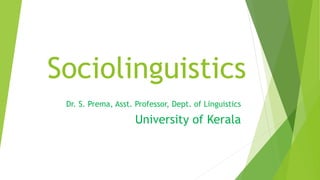
Sociolinguistics.pptx
- 1. Sociolinguistics Dr. S. Prema, Asst. Professor, Dept. of Linguistics University of Kerala
- 2. Two aspects of language 1.Language always changes 2.Language always varies Even then, we can use language……..is it a wonder?
- 3. Why can we use a system which is always changing and varies? Language has two systems 1. An abstract mental system of the language which all the speakers share (langue). 2.The concrete realizations of languages by each speaker and hearer (parole). The abstract system and the concrete realization interacts each other…..therefore language change……
- 4. Why language changes? Why language varies? 1. Language is the product of society. 2. Language exists in society. Society always changes and varies Therefore, languages also varies and changes with society
- 5. Sociolinguistics Sociolinguistics studies language in relation to society.
- 6. sociolinguistics Sociolinguistics is the study of the complex relationship between language and society. 1. explaining why do we speak differently in different social contexts 2. identifying the social functions of language and the ways it is used to convey social meaning. “The study of language in relation to society”
- 7. Basics of sociolinguistics Sociolinguistic variable Speech community Idiolect, dialect and language Restricted and elaborated code
- 8. Variables in sociolinguistics Linguistic variable: Described variation in a language at any level. Social variable: Variation in society like class, caste, gender and region Sociolinguistics variable: Linguistic variable + Social variable = sociolinguistic variable Explained variation in languages based on the social variable.
- 9. Class work What is this? Differences in the pronunciation of ‘fan’ is a linguistic variable. Labio dental f and bilabial f are the linguistic variables /fæn/ labio dental /phan/ bilabial aspirated
- 10. Tell the color by men and women separately There is a gender difference in the knowing of the name of the colure. Woman can remember more color terms……..
- 11. Linguistic variation according to whom we address. Malayalam second person pronoun nī paṛa ‘You tell’ niŋŋaḷ paṛayū ‘You tell’ tāŋŋkaḷ paṛayū ‘You tell’ aŋŋə paṛayū/ paṛaññālum ‘You tell’
- 12. Social variable There is differences in society based on class, caste, gender, age, education, economic status religion and region. These differences reflects on the languages we speak. Variation is based on who speak to whom in which situation
- 13. Socio linguistic variable Once we proves that a linguistic variation is depended up on social variation, that variation in the language can be called sociolinguistic variable. This phenomena is called co-variation A linguistic variable is described variable (HOW) A sociolinguistic variable is explained variable (WHY)
- 14. Social factors/variables The language used by the participants is influenced by a number of social factors. The social variables affecting language: ethnicity, religion, status, gender, level of education, age, and so on; The Participants: e.g. age, ranks, relationships; The Setting: e.g. at home, in a formal meeting, etc. The Topic: e.g. my tennis skills, cooking, exams, family matters etc; The Function: e.g. getting a loan, hiring a maid, asking permission to leave the room, etc
- 15. How to identify sociolinguistic variable 1. Observe a minor variation in the language. 2. Identify who makes that variation (his or her social category) 3. Check all other speakers in the same category makes the same variant. 4. Collect the systematic data. 5. Describe the linguistic variation. 6. Quantify and correlate with social variable. 7. Describe the correlation. 8. Establish at as the sociolinguistic variation 9. Try to explain the motivation of that variation.
- 16. Speech community a group of people sharing a common language or dialect. Mutual intelligibility between dialects…. Malayalam speech community Kannada speech community English speech community
- 17. Idiolect, dialect and languages Idiolect: individual variety of a language. Dialect/ sociolect: Regional or social variety of languages Language: An abstraction of many dialect/sociolect IDIOLECT > DIALECT/SOCIOLECT> LANGUAGE
- 19. Elaborated vs. Restricted code The elaborated code is used in relatively formal, educated situations, permitting people to be reasonably creative in their expression and to use a range of linguistic alternatives. The restricted code is used in relatively informal situations, stressing the speaker's membership of a group, relying on context for its meaningfulness, and lacking stylistic range.
- 20. Two question to teachers? Which code we use in the text book? Which code we use to teach? Elaborated OR Restricted code How many of your students are master in the elaborated code? How this affects their educational attainment?
- 21. Discuss How sociolinguistics is useful for language teaching?
- 22. thank you